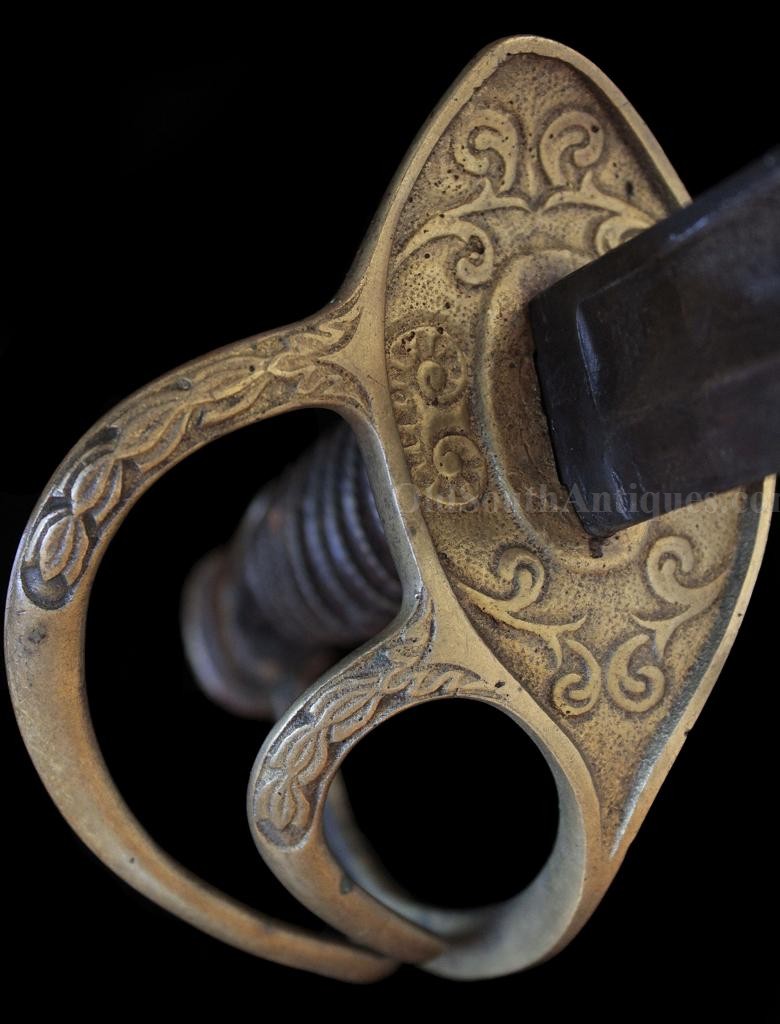
| Catalog | Past Items | Order Info | Terms/Conditions | About Us | Inventory Clearance |
With the capture of Forts Henry and Donelson in the spring of 1862 and the subsequent fall of the state of Tennessee into Union hands, Leech and Rigdon decided to relocate their business to Columbus, Mississippi and build a factory adjacent to the Confederate Briarfield Arsenal. Later in 1862, with Sherman making a threat to Mississippi, the Confederate Government decided to relocate the arsenal to Selma, Alabama. Leech and Rigdon relocated with the Arsenal and remained in Selma for a short period. In March of 1863 Leech and Rigdon separated from the arsenal and moved their operations to Goldsboro, Georgia.
During the period from November 6, 1861 through June 18, 1862, Thomas Leech & Co. Memphis Novelty Works, delivered to the Confederate Army Depot 2,017 swords and scabbards, belts, buckles and side arms before moving to Columbus, Mississippi and reorganizing as Leech & Rigdon.
The Cavalry Officer’s Sword shown here is etched at the ricasso with the company name but only LEECH of LEECH & Co is legible in good light on one side and ..MPHIS NO..LT of MEMPHIS NOVELTY on the other side of the ricasso. This means that it had to be produced in Memphis, between September of 1861 when Leech went into the sword business, and May of 1862 when Memphis fell.
Only ten of this rare pattern are believed to have been manufactured, all intended for prominent men. Numbers 1, 5 and 10 still exist, and two whose numbers are unknown, for a total of five of the original ten. #1 was part of the Hoffman Collection and is presumed to be going into the new U.S. Army Museum. Shown here is #5 which was just recently discovered, #10 is in the Museum of the Confederacy and was owned by General George Washington Rains, an example belongs to the Richard Steuart Collection at the Virginia Historical Society, the number unknown, and an example priced at $95,000.00 was stolen from the Baltimore Antique Arms Show, so if you hear of another for sale, please contact me and I will put you in touch with the owner.
All five swords have identical scabbards and are identical with the exception of the etchings on the blade. For example all have the company name, an ornate floral pattern and a large CS in Old English Script relief etched on the blades, but General George Rains, being an ordinance officer also had crossed artillery on one side, and number five has in addition to the CS on one side a large, full blade width CSA relief etched in Old English Script on the opposite side; the only one made so. This alone makes #5 a special sword among special swords, but there is something much more important etched into the blade; Damascene.
Damascene you ask? Me too. Damascene is the art of reproducing the look of Damascus Steel. Damascus Steel had been recognized since the Crusades as the very finest and strongest of steel, able to flex and not break as well as "split a feather in midair, yet retain their edge through many a battle with the Saracens” according to the Crusaders.
No matter how much they admired it, no one on the American Continent could reproduce this high quality steel, so in the course of making the finest blade they were able to produce, Thomas Leech & Co. finely etched the blade to simulate, or Damascene, the blade of #5. I have included a picture of true Damascus for comparison. Each individual line and swirl had to be individually carved into the blade’s pre etching wax coating. This may have taken weeks of the etch artist’s time, making this probably the most exquisite and expensive Memphis Novelty Works sword ever made. This is so very special that no other Confederate sword, by any maker produced a damascened blade.
The sword’s condition is truly impressive; it retains one hundred percent of its leather grip and its twisted brass wire wrap. The grip, wire and guard are as tight as the day it was manufactured. There are a couple of small areas of light pitting on the blade which I have shown in the pictures. With the exception of these the etching stands out bold and beautiful. There is only one tiny nick in the blade which can be felt better than seen. The blade has never been reshaped or repointed.
Its brass mounted iron scabbard is virtually perfect. There is not a ding, dent or push anywhere in the scabbard body; the brass drag is pinched near the bottom, but is otherwise perfect. The ornately decorated brass ring mounts are perfect as are the original brass rings. The sword and scabbard have a beautifully matching dark, uncleaned patina.
Copyright © 2024 OldSouthAntiques.com All Rights Reserved.
Privacy Policy | Terms of Use
Powered by Web-Cat Copyright © 1996-2024 GrayCat Systems



